Chocolate is one of my personal favorite indulgences. However, it can be difficult to keep chocolate fresh for an extended period of time.
Freezing food is one of the most common techniques to extend a product's shelf life. Is freezing effective with chocolate, though?
Thankfully, you can freeze chocolate in order to extend its shelf life. However, you need to do it correctly or else the chocolate could spoil sooner rather than later.
Today I'll show you exactly how to properly freeze (and thaw) chocolate, how long frozen chocolate lasts, what chocolates freeze the best, and even share my favorite recipes that feature frozen chocolate.
What Are The Benefits Of Freezing Chocolate?
There are quite a lot of benefits to freezing chocolate.
First and foremost, if done properly, it can help to preserve the flavor and texture of the chocolate. Leaving chocolate out, whether in a kitchen drawer or in your pantry, can lead to the chocolate slowly degrading in flavor and texture. By freezing chocolate, it essentially slows down the degradation process.
This is the same reason why you can freeze meats, fruits, and vegetables in order to extend their shelf life. It slows bacteria from spoiling it.
What's more is freezing chocolate prevents it from melting. While chocolate is solid at room temperature, at temperatures above 86 degrees fahrenheit chocolate can start to melt. This can be an issue during the summertime, where temperatures in the 80's and 90's can be quite common in many places.
Last, but certainly not least, frozen chocolate can also be used to make delicious treats like frozen chocolate covered fruits, chocolate ice cream, and I even use it in smoothies.
How To Properly Freeze Chocolate
Freezing chocolate is more of a science than an art. The basic premise consists of ensuring the chocolate is wrapped as tightly as possible to reduce oxygen contact. Here are the exact steps I use when freezing chocolate:
- Start by breaking the chocolate into small pieces. This will help it freeze quickly and allow you to easily grab pieces, if needed later on, without having to work hard to break it apart.
- Put the chocolate in a Ziploc bag or freezer safe bag and remove as much air as possible. I use these reusable bags specifically because they’re airtight and thicker than simple Ziplock bags. You'll want to make sure that the chocolate is wrapped tightly. I sometimes go as far as double wrapping and placing it inside of an airtight container. This is to reduce the amount of oxygen that can get in contact with the chocolate. In an oxygen-free environment, bacteria that causes spoilage are less able to multiply.
- Make sure to label the container with the date that you freeze the chocolate. This is simply so you know when the chocolate has gone bad (more on that below).
- Put the chocolate in a place in your freezer it won't get lost or forgotten. This may seem silly but there have been multiple times when I've gone to clean my freezer and found old frozen foods that I had forgotten. Now I simply place them all in the same section in my freezer with the appropriate labeling.
In addition to reducing oxygen, wrapping frozen chocolate tightly also ensures that the chocolate doesn't come into contact with any humidity. While an unopened freezer isn't that much of a humid environment, if you have an ice maker in it and you're opening the freezer door on a daily basis, you're introducing temperature changes that cause dampness to form. This is the exact reason why you have to "defrost" freezers every once in a while.
This frost can also cause freezer burn, which is a brownish discoloration on the surface of foods. It's not harmful but it does affect the appearance and taste of the food.
How Long Does Frozen Chocolate Last?
Now that you know how to freeze chocolate, the next logical question is: how long does frozen chocolate last?
The answer to this question is a little tricky as it depends on a variety of factors, such as the type of chocolate, how tightly it's wrapped, and the temperature of your freezer. On average, though, I've found that frozen chocolate lasts anywhere from around 4 months to 2 years. Yes, that's a big difference in time but there are many factors that can "mess" with chocolates ability to freeze safely without spoiling.
Does Freezing Chocolate Affect Its Taste?
Yes, freezing chocolate can affect its taste but not always in a bad way. When you freeze chocolate, the water molecules inside of it freeze and crystalize. This causes the chocolate to become slightly harder and more brittle. This is why I recommended breaking the chocolate into small pieces before freezing it.
The flip side to this is that frozen chocolate doesn't melt as quickly as room temperature chocolate does. This is especially beneficial during the summertime when temperatures are high and melting chocolate can be an issue.
In my experience, I have found that frozen chocolate tastes just as good as room temperature chocolate. Obviously there is a slight texture difference, since it's harder. However, when the chocolate melts, its flavor blossoms in your mouth creating a delectable eating experience. This is one of the reasons I love putting Thin Mint Girl Scout cookies in the freezer.
How To Thaw Frozen Chocolate
There are two safe ways to thaw frozen chocolate: in the fridge or at room temperature.
When thawing chocolate in the fridge, you want to make sure that it's in a sealed container so that the chocolate doesn't absorb any of the smells or flavors of the fridge. I usually put it in a container that's airtight but also has a lot of surface area, like a glass casserole dish or a large pyrex container (like this one). This will help it thaw evenly. The downside to this method is that it can take a while for the chocolate to thaw, usually around 12 hours or so.
If you're in a hurry to get your chocolate fix, the second option is to thaw it at room temperature. Although, I wouldn't recommend doing this if the ambient temperature where you are is above 80 degrees Fahrenheit or so as it will cause the chocolate to slowly melt.
Using the room temperature method, I usually place the chocolate in a bowl and then set that bowl in a larger bowl filled with ice water. This is to balance the temperature so the chocolate thaws evenly. Of course, you could always place the chocolate out on your kitchen counter but it's more likely to thaw from the outside in. This can result in a room temperature (or melted) outer layer and a frozen inside.
You may be wondering why not use a microwave on a low setting to lightly "heat" the frozen chocolate bar to thaw it out. Unfortunately, this will have the same effect as simply letting it thaw on your kitchen counter, un-aided, at room temperature. The outer layer could begin to melt, while the inside stays frozen.
Signs Your Frozen Chocolate Bar Has Gone Bad
You'll want to know what to look for when checking if frozen chocolate has gone bad since its shelf life varies so much when frozen.
First, if the chocolate has been exposed to air and moisture, it will start to form a white film on the surface. This is called sugar bloom and is caused by the sugar in the chocolate crystallizing. It's not harmful but it does affect the appearance and taste of the chocolate.
Oxygen and moisture can also form large, grayish-black spots on chocolate. This is mold and it's definitely not something you want to be eating.
Second, if the chocolate has been stored in a humid environment, it will start to develop ice crystals. Ice crystals are a sure sign that the chocolate has been frozen for too long. Similarly, chocolate can also get freezer burn, which is caused when the ice crystal formation leads to moisture loss. It looks like this. This will make the chocolate taste bland and dry.
Third, if you're experiencing any off-flavors or smells, the chocolate has most likely gone bad. This is usually a sign that the way that the chocolate has been stored was incorrect and led to a warm, humid, or oxygen-rich environment, that allowed to bacteria grow.
Last, from my experience, if the chocolate has been frozen for over a year, it's likely to have lost most, if not all of its flavor. That's not to say it has gone bad, but it may not be worth using at this point.
What Type Of Chocolate Freezes Well?
Not all chocolate freeze well. In fact, most milk and white chocolates freeze poorly because of the high percentage of sugar in them. Because of this, they tend to form sugar bloom and ice crystals more easily than dark chocolate does.
Dark chocolate is freeze-able because it contains a lower level of sugar and more cocoa butter, which helps it to remain solid at colder temperatures. Also, the addition of extra cocoa butter (or vegetable oil) to milk or white chocolate can help increase its freeze-ability.
All that to say, if you're looking to freeze chocolate, try to stick with darker varieties.
What Other Varieties Of Chocolate Can You Freeze?
As we went over above, some types of chocolate freeze better than others. However, there is more than just white, milk, and dark chocolate.
Chocolate can be turned into a wide variety of different desserts and treats. Let's look at what you can and cannot freeze when it comes to other varieties of chocolate...
Can You Freeze Chocolate Truffles?
Yes, you can freeze chocolate truffles. Because they are already coated in a chocolate shell, they will not develop sugar bloom or ice crystals like regular chocolate bars will. However, if the truffles are filled with a cream or custard-based filling, you'll want to make sure that it is stable at cold temperatures before freezing them. This means that the cream or custard-base should be made with ingredients like cornstarch or flour which will help thicken and stabilize it when frozen. Here's a good recipe that should do well frozen.
Can You Freeze Chocolate Cake?
No, you cannot freeze chocolate cake. The reason being is because cake contains eggs and milk, which, when frozen and then thawed, can cause the cake to become very dry, crumbly, and dense.
Can You Freeze Chocolate Mousse?
Yes, you can freeze chocolate mousse. In fact, it's a great way to keep it fresh for longer periods of time. Just make sure that the mousse is stable at cold temperatures before freezing it. This means that the mousse should be made with ingredients like cornstarch or flour which will help thicken and stabilize it when frozen.
Can You Freeze Chocolate Cookies?
Yes, you can freeze chocolate cookies. However, you'll want to make sure that they are baked all the way through before freezing them. This means that they should be golden brown and not doughy in the center when you take them out of the oven. Once they are baked, let them cool completely before freezing. Letting them cool at room temperature will help them freeze faster and prevent them from being soggy when you go to thaw them later on. Here's one of my favorite chocolate cookie recipes that should do well in the freezer.
Can You Freeze Chocolate Pudding?
Yes, you can freeze chocolate pudding. However, you'll want to make sure that it is stable at cold temperatures before freezing it. This means that the pudding should be made with ingredients like cornstarch or flour which will help thicken and stabilize it when frozen. This is a delicious recipe that should do well in the freezer.
My Favorite Frozen Chocolate Recipes
Now that you know how to freeze chocolate, it's time to put that knowledge to good use! Here are a few of my favorite recipes that use frozen chocolate to bring out the overall flavor and texture of the treats.
Frozen Chocolate-Covered Banana Bites
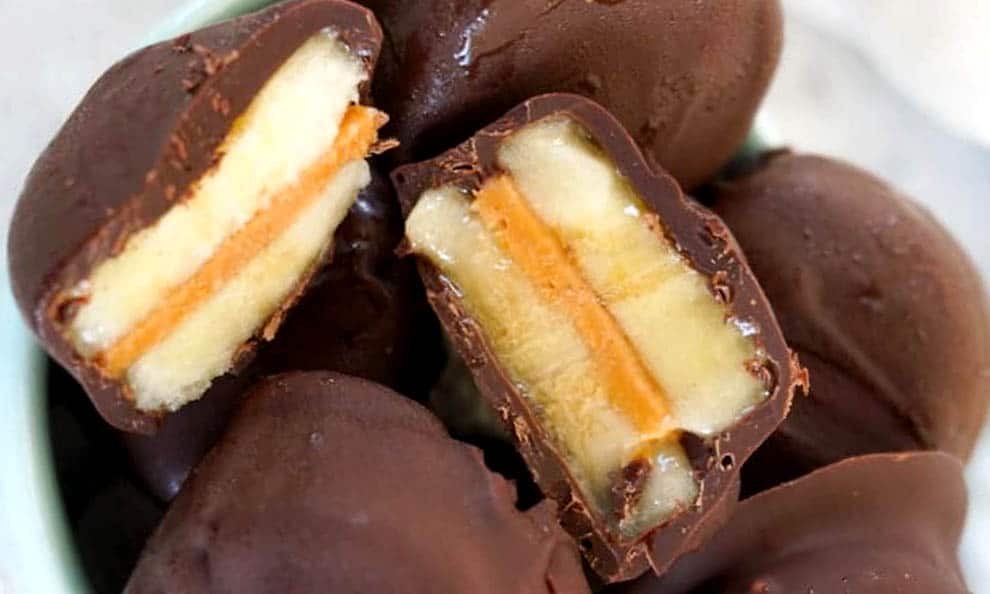
Ingredients:
- 1 banana
- 2 tablespoons of chocolate chips
- 1 tablespoon of peanut butter
Directions:
- Cut the banana into bite-sized pieces.
- Melt the chocolate chips and peanut butter in a microwave-safe bowl or in a saucepan over low heat.
- Dip the banana pieces into the melted chocolate and peanut butter.
- Place them on a baking sheet lined with parchment paper and freeze for 30 minutes.
- Serve and enjoy!
Frozen Chocolate-Covered Strawberry Bites
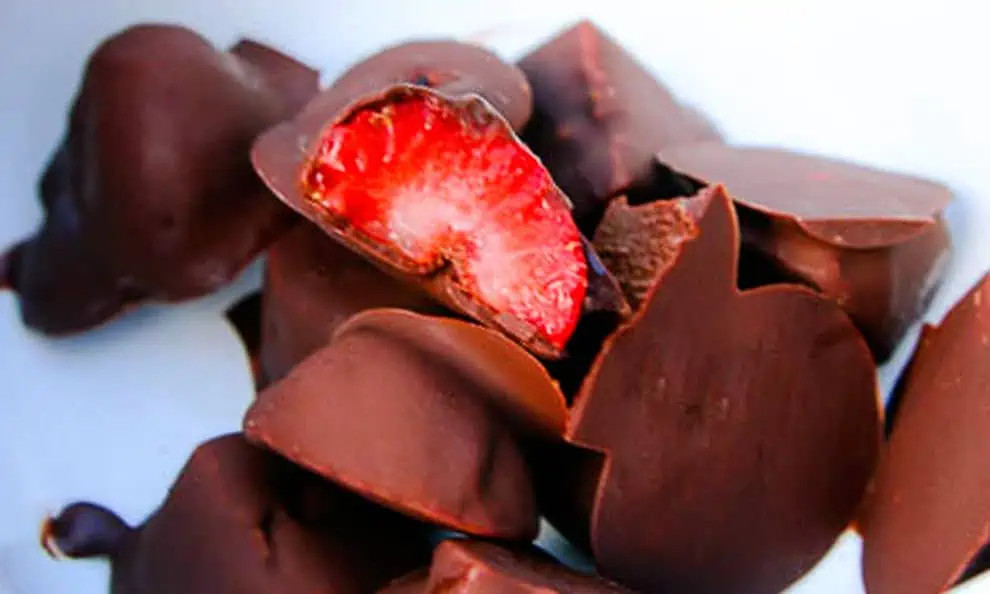
Ingredients:
- 1 pound of strawberries
- 1 cup of chocolate chips
- 1 tablespoon of vegetable oil or coconut oil
Directions:
- Hull the strawberries and cut them into bite-sized pieces.
- Melt the chocolate chips and vegetable oil (or coconut oil) in a microwave-safe bowl or in a saucepan over low heat.
- Dip the strawberry pieces into the melted chocolate and coat them completely.
- Place them on a baking sheet lined with parchment paper and freeze for 30 minutes.
- Serve and enjoy!
Frozen Chocolate-Covered Blueberry Bites
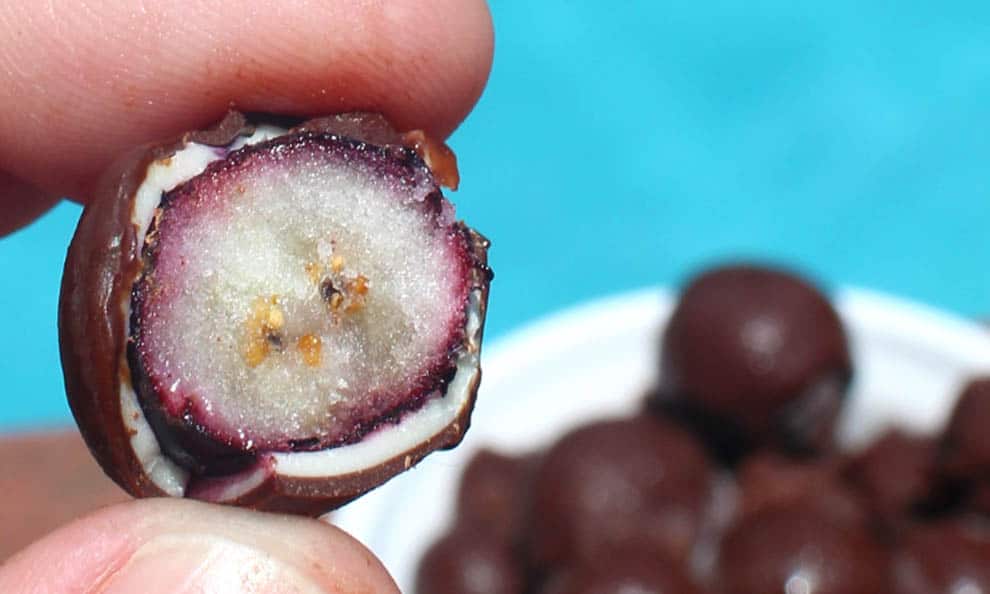
Ingredients:
- 1 cup of blueberries
- 1 cup of chocolate chips
- 1 tablespoon of vegetable oil or coconut oil
Directions:
- Rinse the blueberries and pat them dry.
- Melt the chocolate chips and vegetable oil (or coconut oil) in a microwave-safe bowl or in a saucepan over low heat.
- Dip the blueberry pieces into the melted chocolate and coat them completely.
- Place them on a baking sheet lined with parchment paper and freeze for 30 minutes.
- Serve and enjoy!
Beyond The Freezer: Alternative Ways To Store Chocolate
While freezing chocolate is a great way to extend its shelf life, it's not the only way. Here are a few alternative ways that you can store chocolate without having to freeze it.
Storing Chocolate In A Pantry
If you have a pantry, you can store chocolate in there by keeping it in an airtight container. This will help to keep the chocolate from absorbing any unwanted flavors or smells from the other foods in your pantry.
Chocolate stored this way still has a decently long shelf life but it will vary depending on the type of chocolate you're storing. For example, milk chocolate generally lasts for more than a year, dark chocolate for more than two years, and white chocolate for around 4 months.
Storing Chocolate In The Fridge
If you don't have a pantry or if you want to store your chocolate in a colder environment, you can store it in the fridge. Just make sure that you keep it in an airtight container (or wrap it tightly in plastic wrap) to prevent it from absorbing any unwanted flavors or smells from the fridge.
Chocolate stored in a fridge will last for around 2 to 3 months.
Wrapping Up
Whether you're freezing chocolate for some delicious recipes or to simply prevent it from melting, if done correctly, it can help keep your favorite sweet treat fresh.
If there's one thing you get from this article I want it to be that, regardless of the type of chocolate or even where you choose to store it, keep it well wrapped and in an airtight container. This will prevent the majority of freezer burn, frost, sugar bloom, and mold issues we covered above.
Have a question about freezing chocolate? Let us know in the comments below!

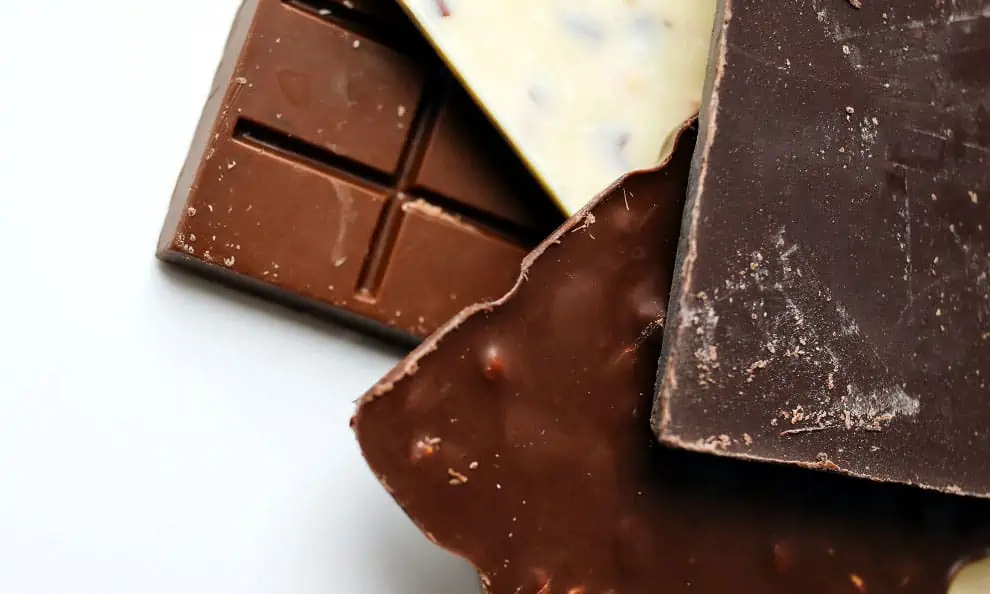

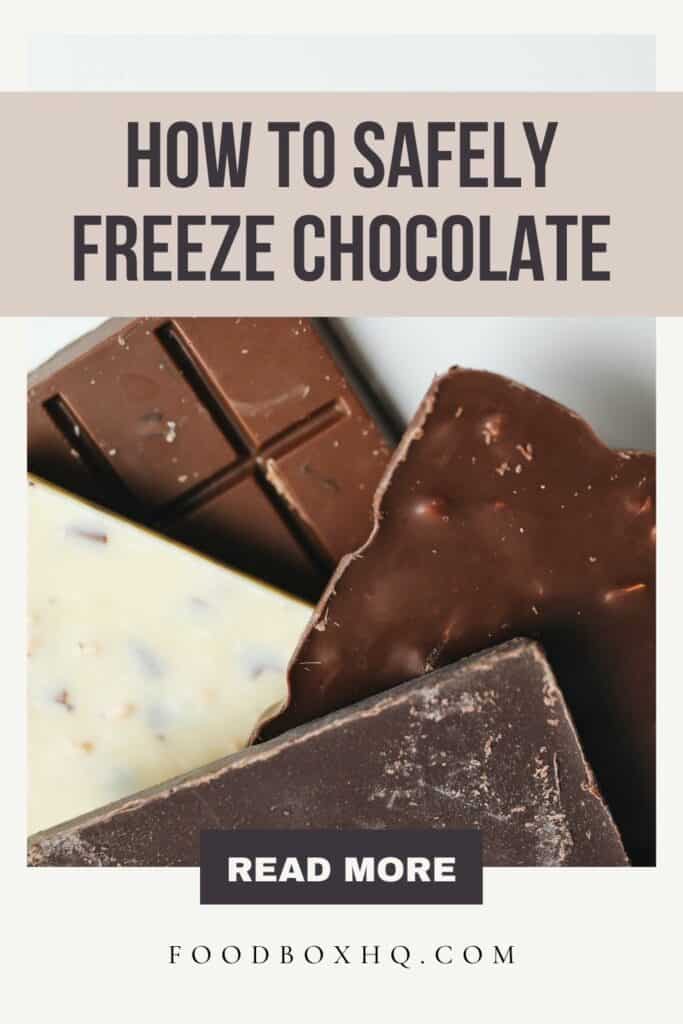









THe article about freezing chocolate is helpful, thanks. However, I got interested in the chocolate covered fruit ideas pictured. The photos don't seem to match up with the actual instructions...the banana bites clearly have peanutbutter sandwiched between them, but you say to stir the pb and chocolate together? And the blueberry has a layer of white, then a layer of chocolate. I don't understand. (they look delicious and easy to make, though)
Thank you for sharing your knowledge regarding the freezing of chocolate. I had some boxed chocolate from Christmas. I was eating it slowly, not wanting to raise my blood sugar, but I ignorantly left the large box unopened. I wasn't ready to gorge myself on chocolate, so I thought I'd ask the question. You saved me from a sugar rush. Now, it broken into small T-Ware containers in my freezer so I can enjoy from time to time.
Thanks, again!
You're welcome!
I read all your information, and find very helpful. But can you freeze boxed Russell Stover chocolates? I bought a BIG box from an outlet store and would like to freeze some.